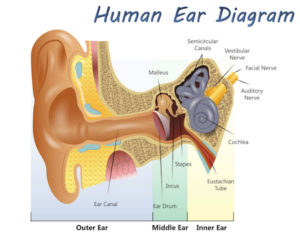Have you ever wondered how you hear? How does the beep of the microwave leave that device, enter your ear and tell your brain that your popcorn is done? While it may seem simple, your Portland audiologist is here to tell you that it is surprisingly complicated.
What Makes Up the Ear?
There are three sections of the ears: the outer, middle and inner ear. Each section plays an important role in the hearing process.
The Outer Ear
The outer ear is also called the auricle or pinna. The part that, for lack of a better term, sticks out of your head and is visible to others, is responsible for collection the sound waves and funneling them into the ear canal. The sound waves travel along until they hit the eardrum (tympanic membrane) and create a vibration.
The Middle Ear
The vibration, caused by the sound wave hitting the eardrum, stimulates the movement of the ossicles, three tiny bones within the middle ear. They are known are the malleus (hammer), incus (anvil) and stapes (stirrup). Fun fact alert: the stapes is the smallest bone in the human body.
The stapes is attached to the oval window, which connects the middle and inner ear.
The Inner Ear
When the vibration reaches the oval window, it causes the liquid within the cochlea to move. The cochlea is a fluid-filled, hair-lined structure within the inner ear. The movement of the liquid causes the hair cells to move, which creates an electrical impulse. The impulse travels down the auditory nerve to the brain. There, the signal is interpreted as sound and there you have it – the hearing process is complete.
How Does Hearing Loss Occur?
If the outer or middle ear becomes damaged, typically from trauma or disease, it is known as conductive hearing loss.
Damage to the inner ear is known as sensorineural hearing loss or nerve deafness. This type of hearing loss occurs when there is damage to the hair cells within the cochlea, which prevents electrical signals from reaching the auditory nerve and brain. This type of hearing loss can be caused by:
- Injury
- Disease
- Aging
- Genetics
- Ototoxic medications
Patients can also develop mixed hearing loss. This is when you have damage to both the inner ear and outer or middle ear.
To learn more about hearing loss, contact your Portland audiologist today.



